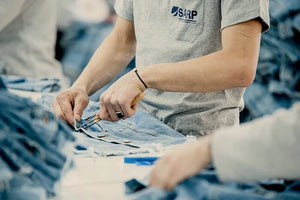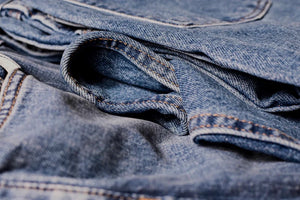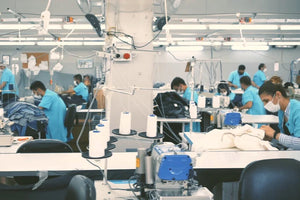SVHC: Substances of particular concern in our clothing - and how to avoid them
May 06, 2023
SVHC (Substances of Very High Concern) are chemical substances that are classified as particularly hazardous due to their potentially harmful effects on humans and the environment. Studies show that many items of clothing on the market still contain such SVHC. In this blog article, you will learn what SVHC are, how they are regulated, and how you can avoid them.
What are SVHCs?
SVHC stands for "Substances of Very High Concern". This term is used by the European REACH regulation to identify certain chemicals that may pose a high risk to humans and the environment. SVHC can
- be carcinogenic
- change the genetic material
- have toxic effects on prolonged skin contact
- Cause reproductive or developmental disorders
- accumulate in the environment or enter the food chain
SVHCs are undesirable but not yet banned because their harmful effects have not yet been sufficiently proven. Proof often requires long-term studies. In this sense, SVHCs are on a watchlist for potentially dangerous substances. There are currently over 200 substances on this list .
Chemicals classified as SVHC are of particular concern because they have the potential to cause adverse effects on human health and/or the environment.
How do SVHCs get into clothing?
Many chemicals are usually used to produce textiles. This starts with the cultivation of the natural fibers, where fertilizers and pesticides are used, which can contain SVHCs. Fabrics such as polyester or nylon can also contain SVHCs that have been added during the manufacturing process or in later stages of production.
During the manufacturing process, chemicals can enter clothing during the dyeing, printing, bleaching and finishing processes. SVHCs can also enter clothing through contamination from other products or sources. In addition, buttons, zippers and other embellishments can contain lead, cadmium and other SVHCs that can be released through contact with skin or abrasion.
Although the finished textiles are usually washed out, residues can remain. In addition, the washed-out chemicals enter the environment via wastewater.
What percentage of clothing contains SVHC?
A 2018 study conducted by the Swedish Chemicals Agency found that almost 40% of the garments tested contained traces of SVHCs, mainly phthalates and perfluorooctanesulfonic acid (PFOS).
Although this study examined only a limited number of garments and is not necessarily representative of the entire clothing market, it does show that there is still a risk for consumers to encounter harmful chemicals in garments. For this reason, it is important that manufacturers take strict measures to ensure that their products do not pose any potential risks to human health or the environment.
How are SVHC regulated?
The use of SVHC in products is regulated by the European REACH regulation. REACH stands for "Registration, Evaluation, Authorisation and Restriction of Chemicals" and is a regulation that aims to protect human health and the environment from the effects of chemicals. The European Chemicals Agency ECHA maintains a candidate list that is regularly updated as new substances are identified. There are currently over 200 SVHC on this list.
According to the REACH regulation, manufacturers and retailers are obliged to provide information about SVHC in products upon request. This obligation to provide information applies as soon as SVHC exceeds a limit of 0.1 percent by weight. Unfortunately, this obligation to provide information has so far only been inadequately fulfilled. In 2019, the European Supervisory Authority found that 88% of suppliers of products containing SVHC do not fulfill their obligation to provide information or do not do so sufficiently.
Which certificates confirm the absence of SVHC?
Companies can have their textile products certified according to OEKO-TEX Standard 100. This checks whether the SVHC limit values are complied with. For many SVHCs, the limit is 1000 mg/kg, for some even lower. The OEKO-TEX certification confirms that the raw material or product in question is free of SVHC.
Similar to OEKO-TEX certification, GOTS certification also meets strict limits for substances, but goes a step further by checking the entire production chain for environmental and social standards. GOTS requires OEKO-TEX certification for certain raw materials so that the entire product can be GOTS certified. GOTS also requires regular laboratory tests to check the garments for SVHC residues.
With an OEKO-TEX or GOTS certification, consumers can be assured that the product does not contain any SVHC. With other certificates (e.g. OCS), this certainty is not available. In such cases, the consumer can send a request to the manufacturer or retailer, as they are obliged to provide information.
If ecological standards are applied and checked during production, the probability that SVHCs are present is much lower. Strict seals such as the GOTS certificate mentioned above set limits for SVHCs.
How can I ask a manufacturer if the product contains SVHC?
The European Chemicals Agency ECHA has developed a free app that can be used to check products for SVHC. With the Scan4Chem app, you can scan the barcode of a product. If the product is registered, the app shows that it does not contain any SVHC. Otherwise, you can use the app to send a request to the manufacturer, which generates a pre-formulated email to the manufacturer. The manufacturer is then obliged to provide information.
ConclusionSVHC are chemical substances that are classified as very high concern due to their properties. They can have harmful effects on human health and the environment. Clothing can also contain SVHC. OEKO-TEX or GOTS certified products, such as those from TORLAND, are free of SVHC. For other products, you can use an app to ask the manufacturer whether the product contains SVHC above the threshold of 0.1%.
Sources:
- https://echa.europa.eu/en/regulations/reach/understanding-reach
- https://www.askreach.eu
- https://echa.europa.eu/candidate-list-table
- https://www.umweltbundesamt.de/themen/chemikalien/chemikalien-reach/reach-fuer-verbraucherinnen-verbraucher/scan4chem-smartphone-app-web-app#scan4chem
- https://www.oeko-tex.com/en/our-standards/oeko-tex-standard-100
- https://global-standard.org/en




